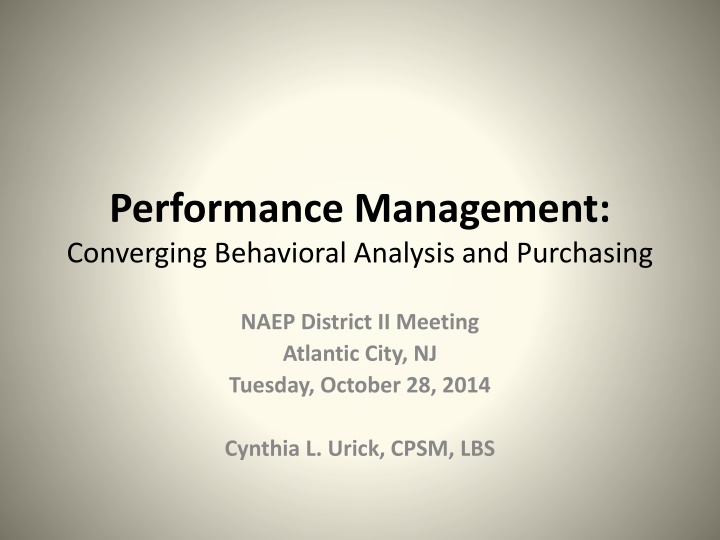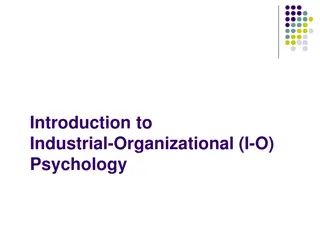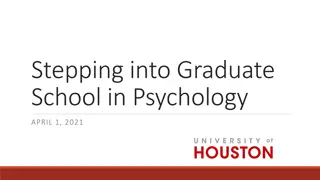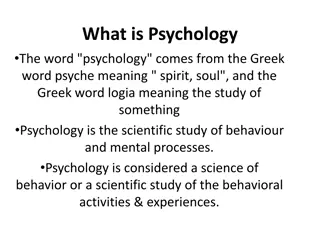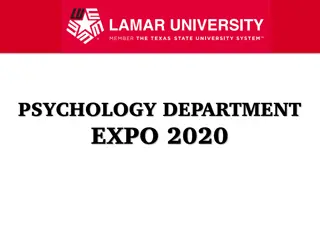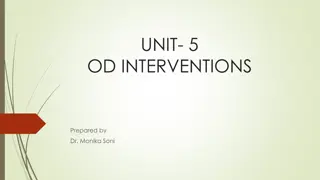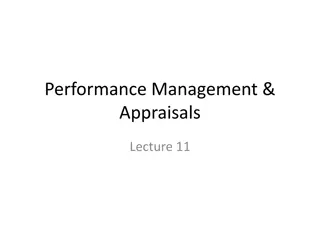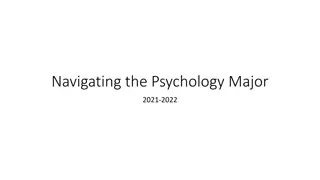Performance Management and Behavioral Analysis in Organizational Psychology
Performance Management involves utilizing Behavioral Analysis techniques to optimize employee behavior and enhance organizational outcomes. By focusing on behaviors rather than personal histories, managers can effectively bring out the best in employees. The ABC Model of Behavior, with its emphasis on Antecedents, Behaviors, and Consequences, plays a significant role in understanding and influencing employee performance. Learning objectives include explaining behavioral analysis theory, utilizing data for change measurement, and improving communication skills for implementing change.
Download Presentation

Please find below an Image/Link to download the presentation.
The content on the website is provided AS IS for your information and personal use only. It may not be sold, licensed, or shared on other websites without obtaining consent from the author.If you encounter any issues during the download, it is possible that the publisher has removed the file from their server.
You are allowed to download the files provided on this website for personal or commercial use, subject to the condition that they are used lawfully. All files are the property of their respective owners.
The content on the website is provided AS IS for your information and personal use only. It may not be sold, licensed, or shared on other websites without obtaining consent from the author.
E N D
Presentation Transcript
Performance Management: Converging Behavioral Analysis and Purchasing NAEP District II Meeting Atlantic City, NJ Tuesday, October 28, 2014 Cynthia L. Urick, CPSM, LBS
The ABC Model of Behavior 10/28/2014 Cynthia L. Urick, CPSM, LBS 2
Learning Objectives Explain the theory and application of behavioral analysis Identify and demonstrate ways to use data to measure change Identify effective communication skills for use in implementing change 10/28/2014 Cynthia L. Urick, CPSM, LBS 3
Differentiating Treatments Psychotherapy Treat people with mental disorders to understand their illness Teaches people strategies and gives them tools to deal with stress and unhealthy thoughts and behaviors Helps patients manage their symptoms better and function at their best in everyday life Subjective (thoughts, feelings, emotions) Considered healthcare Behavioral Analysis Focuses on behavior itself in the here and now rather than mentalistic causes of behavior. Practical application in organizational psychology to enhance employee performance Used in mental health treatment to build abilities in children and adults with disabilities and increase academic skills in school settings. Objective (behaviors) Since all organizational results are the product of human behavior, business is behavior. 10/28/2014 Cynthia L. Urick, CPSM, LBS 4
What is Performance Management? It's a way of getting people to do what you want them to do and to like doing it. The Fundamental goal of Performance Management is to bring out the best in people while generating the highest value for the organization. Techniques and practices are derived from Behavior Analysis, the scientific study of behavior. Because behaviors relate to the here and now, managers don t have to pry into employees private lives or personal histories to bring out the best in them. 10/28/2014 Cynthia L. Urick, CPSM, LBS 5
The ABC Model of Behavior 10/28/2014 Cynthia L. Urick, CPSM, LBS 6
Antecedents What are they? Stimuli in the environment that increase the likelihood that a certain response will occur All resources provided to help people do their jobs Instruct individuals to do something in a particular way Set the stage for work behavior or performance to occur but they do not guarantee that it will occur Examples At work: checklists, directories, flowcharts, operating manuals, polices, procedures, training General: telephone ring, red light, advertising (packaging, commercials) Feelings: hunger, stress, frustration, accomplishment Words that refer to antecedents: stimulate, signal, cue, prompt, trigger, encourage, motivate 10/28/2014 Cynthia L. Urick, CPSM, LBS 7
Behaviors What are they? Observable, measurable activity of a person Reliable Objective rather than judgmental Present tense: what people are doing Past tense: What people have produced (results) Examples Behavior: read instructions, add numbers, place stamp on envelope, write on form, use credit card, verbal behavior (do what you say), attendance Behaviors are not: opinions, professionalism, creativity, enthusiasm, attitude, teamwork, supervising, delegating, being proactive, values, lazy, morale 10/28/2014 Cynthia L. Urick, CPSM, LBS 8
Consequences People do what they do for the positive consequences they receive or for the negative consequences they are able to avoid. The single most effective tool a manager has for improving employee performance and morale Behavioral events that follow a behavior and change the probability that the behavior will recur in the future 10/28/2014 Cynthia L. Urick, CPSM, LBS 9
The Four Consequences and Their Effects 10/28/2014 Cynthia L. Urick, CPSM, LBS 10
The Most Powerful Responses are: *Note that we are walking in the performer s shoes when determining consequences. 10/28/2014 Cynthia L. Urick, CPSM, LBS 11
Positive Reinforcers Any event, action, or object that has increased the frequency of a behavior. Social attention, gestures, words, or symbols Examples: written messages, verbal praise, present results to upper management, brag sheet outlining team performance Tangible economically valuable Examples: Something with the company logo, food, gift certificate, give the recipient a story to tell Work-related naturally occurring events Examples: desired training, breaks, increased job responsibility, preferred job assignments, flexibility in work scheduling, autonomy in setting/deciding goals 10/28/2014 Cynthia L. Urick, CPSM, LBS 12
Taking Ownership in Your Work Area http://aubreydaniels.com/taking-ownership-your-work-area 10/28/2014 Cynthia L. Urick, CPSM, LBS 13
Yearly through AP Over half of the invoices are <$500 Qty % of Invoices <$100 Qty. Invoices <$500 % of Invoices <$500 Qty. Invoices <$1,000 % of Invoices <$1,000 Qty. Invoices Invoices <$100 Single Date Transactions 2011 8,585 2,073 24.1% 4,434 51.6% 5,601 65.2% 734 2012 8,347 2,008 24.1% 4,549 54.5% 5,717 68.5% 752 2013 2014 (9 mo.) 7,841 1,871 23.9% 4,286 54.7% 5,360 68.4% 717 5,911 1,394 23.6% 3,214 54.4% 4,001 67.7% 586 10/28/2014 Cynthia L. Urick, CPSM, LBS 14
Flow of a paper invoice through AP Paper invoice received through campus mail Auditor authorizes payment Checks are printed Invoice proceeds through signature authority flow through PN3 Envelopes opened manually Checks >$5,000 are hand-signed Label with bar code is placed on invoice for identification Invoices are coded individually by AP Checks are placed in envelopes Invoices are received from email and uploaded to PN3 Invoices are scanned from Ricoh MFD to email Checks are mailed First Class ($0.49) Orange fill end user; Blue fill - accounting
Flow of a current pcard transaction Accounting manually tracks receipt of employee expense reports from 140 cardholders Cardholder receives monthly paper statement through campus mail Accounting reminds lagging cardholders to get their statements in Mater list of statements are organized by credit card number so accounting re-organized alphabetically Envelopes opened manually, statement removed Accounting provides list of late cardholders to VP of finance (if applicable) Accounting receives a master list of all University credit card statements through campus mail Accounting posts allocations to Great Plaines GL (late accounts are posted to a general account) Cardholder completes an employee expense report, attaching receipts and statement Cardholder seeks hand signature from supervisor Cardholder sends statement to accounting through campus mail Orange fill cardholder; Blue fill - accounting
Pinpoint desired behavioral changes Partnered vendors: Increase effective invoicing Combine monthly transactions onto one invoice Provide specific details: Include subtotals for each department code, yearly total invoice quantity of 12 or fewer. Consequence: Efforts to be reflected verbally and in writing on vendor report card P-card holders: Increase use for transactions <$500 Educate cardholders and mangers on how to appropriately increase use of p-card Provide a date in which low-dollar invoices from cardholders will cease to be paid through AP (extinction) Consequence: Verbal affirmation to individual and manager, clerical assistance P-card holders: Increase use for 1-transaction vendors Educate cardholders and managers on how to appropriately increase use of p-card Consequence: Verbal affirmation to individual and manager, clerical assistance 10/28/2014 Cynthia L. Urick, CPSM, LBS 17
.and additional observations Increase on-contract buying Increase purchase requisition and contract compliance Identify contract opportunities 10/28/2014 Cynthia L. Urick, CPSM, LBS 18
When reaching out to staff. Look for the positive (4:1) Be honest and sincere Have an open mind Use reflective listening skills Take staff where they are today Set them up to succeed (antecedent) Take a non-judgmental approach Use reinforcers Say what you mean and mean what you say Understand that sustained change takes time 10/28/2014 Cynthia L. Urick, CPSM, LBS 19
References Daniels, AC. Management Traps: "You Did A Good Job But..." and Other De- Motivators https://www.youtube.com/watch?v=pLq-skUOflY Daniels, AC. Positive Reinforcement in the Workplace. http://aubreydaniels.com/behavioral-minute-positive-reinforcement-and- relationships Daniels, AC. Taking Ownership in your Work Area http://aubreydaniels.com/taking-ownership-your-work-area Daniels, AC, Bailey, JS. Performance Management: Changing Behavior that Drives Institutional Effectiveness, 2014 (Ed 5). National Institute of Mental health. http://www.nimh.nih.gov/health/topics/psychotherapies/index.shtml Sinek, S. How Great Leaders Inspire Action. http://www.ted.com/talks/simon_sinek_how_great_leaders_inspire_action 10/28/2014 Cynthia L. Urick, CPSM, LBS 20
